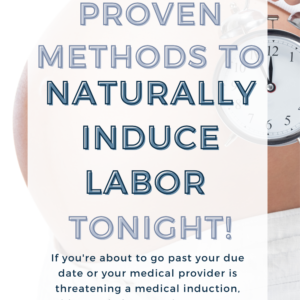You’ve seen the movies and heard the horror stories of women suffering through labor pain. The truth is natural labor doesn’t have to be painful. Learn the biggest labor pain mistakes that most mamas make during childbirth, how to avoid them and how to have the natural, pain-free birth you deserve.

Labor and Delivery
How many movies or TV shows have you seen where a woman has a beautiful, calm natural labor? Probably none. It’s not because natural childbirth is painful and awful like it’s portrayed. It’s because it makes for better TV, better ratings. These snippets are funny and go along with the character or the storyline. It also creates a culture of fear of childbirth. So much fear that most women opt right for the epidural without a second thought.
That’s why you also know so few people who actually have had a natural birth. We live in a world where labor is becoming a means to an end. Every mama wants to meet their beautiful healthy baby. But most don’t want to face the labor and labor pain it takes to get there. Our culture has made it seem too scary, painful and uncontrollable.
Or maybe you’ve attempted natural labor in a previous birth, and it was painful. You didn’t have the tools and tips you needed to properly cope.
What every expecting mama needs to know is there’s a better way. This is everything you need to know about labor pain, how to avoid it and how to have a calm and pain free birth experience.

Labor Pain Problems to Avoid
There’s no doubt about it that your body goest through a lot when it births a baby. Your uterus contracts and restricts to prepare your cervix and move baby down and out the birth canal. Your cervix dilates and effaces so baby can fit through. Your hips and pelvis open and move to make room for baby. Physically, it’s massive effort and work.
Labor is intense. It’s a mental and physical marathon. To say that birth is painful would be misrepresenting it. A painful birth experience is causes suffering. A laboring mom unintentionally creates unnecessary labor pain by accidentally doing the following things. Understanding these mistakes and knowing how to cope and avoid them will make for a happier and easier labor and delivery.
Pain Theory
Pain typically indicates that something is wrong with our bodies. A sore throat indicates a cold. A sharp paper cut stings from the injury. It’s hardwired into us to associate pain or anything that feels differently that something is wrong.
So when contractions start to get a little bit intense at the end of the first stage of labor, a lot of women panic. Their fight or flight instinct immediately takes over. The intensity can be scary. You’ve never felt anything like this before. Since the labor pain feels somewhat painful and very different from anything you’ve experienced, you panic.
Related: 5 Relaxation Techniques for a Peaceful Pain Free Labor
Childbirth labor sensations don’t mean something is wrong. It’s the exact opposite, in fact. The physical effort of your body contracting means that labor is progressing. That’s a good thing! If you can mentally prepare yourself to know that labor sensations indicate progress, instead of something being wrong you can deal with the discomfort more easily.
Once you make this mental leap. you’re able to relax and let your body and contractions work more easily by using these relaxation techniques.
If you can’t, you make contractions worse by decreasing oxygen supply and falling into the Fear-Tension-Pain Cycle.
Fear-Tension-Pain Cycle

Labor Pain Fear
When we experience fear, like the fear of surprisingly intense labor pain, our brain release adrenaline that causes our bodies to enter fight or flight. We can’t control it – it’s how we’re programmed as mammals. It’s meant as a survival instinct to protect us, but it works against us in childbirth.
The problem with this is as a birthing mother, you enter the Fear-Tension-Pain cycle, originally described by Grantly Dick-Read, author of Fear in Childbirth.
When you fear contractions, you restrict the flow of blood to your muscles, causing tension. The less oxygen for muscles to do their work, the more pain you feel. The more pain you feel, the more you fear the next contraction. This restrict blood vessels even more, which causes more pain and leads to even more fear.
Accidentally, you’re making each and every contraction worse by being in this cycle. Plus, since you’re working against your body, the contractions have to work twice as. They have to work against you and work to contract your cervix open. Labor pain is even worse and now longer than the mother who can relax and let the contraction fully and properly work.
Labor Confidence
Knowing that labor contractions means your body is progressing forward toward meeting your baby is one mental leap. Remind yourself of this by going into labor equipped with positive birth affirmations. Hang them around your room, let your husband read them to you or read them to yourself. These will keep your mind positive and out of the fear cycle.
Additionally, avoid the Fear-Tension-Pain cycle by researching and having a plan for the intensity of labor. When you go into labor knowing you have a bag of tricks for every stage of labor pain, you know you’re mentally and physically ready. Fear won’t be an issue.

Destresser Breath
I teach different strategies in my Natural Birth Bundle, but my number one tip for relaxation is the Destresser Breath. It eliminates anxiety and achieves relaxation through a deep inhale and long exhale. Close your eyes. Put your hands on your belly and take a deep inhale until you feel your belly rise. Breath in through your nose, which allows you to inhale at a slow, steady rate. Imagine you’re sending energy and air to your baby. Focus on a full, deep, slow breath for 4-6 seconds.
Exhale through your mouth for 6-8 seconds. Focus on keep your belly relaxed. Let it just exist and hang in gravity without thought or tension. Focus your mind on your breath. Count your inhale and exhale, taking as many breaths as your contraction lasts.
Practice these breathing and relaxation strategies during pregnancy and in early labor so you’re a pro by active labor and transition.
Lack of Movement
Another big mistake that moms make during labor is they don’t move enough. It’s understandable why. Moving can be scary when you’re afraid of labor pain. You don’t want to make labor sensations worse or some are even scared of their labor progressing because they’re afraid of what the next stage of labor or contraction will feel like.
So they stay still.
Both your baby and pelvis move a lot during labor. They can’t move if you don’t move, so labor pain worsens, stalls, and can lead to unwanted interventions.
Baby’s movement for labor
What you can’t see during labor is that baby is doing just as much work on the inside as you can feel on the outside. Baby needs to get into proper position for birthing. Occiput anterior is the best position for labor, and the position most babies get in. This means baby is head down, and her face is facing your tailbone.
During labor, also needs to move and align her shoulders with the widest part of your body. This is how she easily slips out during birth. Lastly, the longer and more pressure baby’s head puts on the cervix, the more quickly gravity can speed dilation and effacement.
Related: The How-To Guide for Natural Birth
It’s so much work for baby to make sure she’s in the proper spot for labor. Birth is designed for her to be in this spot to fit through the birth canal. So while your contractions are working and you’re working to relax, baby’s also working to get into proper position. It takes a lot of work in such a small space!
Pelvic movement
As baby descends into the birth canal, your pelvis opens and expands to make room. This is made possible by the relaxin hormone. Your ligaments and tendons soften so the pelvic bones can properly open.
Your pelvis widens so the crown and shoulders can pass. Without this widening, baby would get stuck. Moving and changing positions assists the pelvis in this process.
Just like with baby, if you remain still or in one position during labor, you’re making labor pain worse. Your pelvis isn’t able to open. It will be more painful for the pelvis to work to widen. It’s also more uncomfortable as baby tries to descend into a smaller spot.
LABOR MOVEMENT
When you are staying still, you’re not giving baby any extra help moving into position or gravity help to dilate and efface your cervix. It also restricts the space in your belly, so baby may not be able properly move. That’s why moms who get epidurals often face a stalled or longer labor. Little movement and bed confinement makes it hard for labor to progress and baby to move.

They both work against you, causing more labor pain. The more you move, the better baby can move into occiput anterior position.
Moving also allows more pressure and gravity put on your cervix to quickly dilate and efface. The quicker that happens, the quicker labor moves along. You can do this through bouncing and tilting on a yoga or birth ball, squatting, changing labor positions or simply walking.
Changing labor positions also lets you find what’s the most comfortable during contractions. Coping during labor pain differs for every woman. Alternate between labor positions until you find one that allows you to relax and focus the most.
Labor Pain Conclusion
Labor pain is a different sensation that you’ve never experienced before. It can be intense but not overtly painful or cause suffering. Women often mistake labor sensations for something being wrong. Unfortunately, a lot of moms who want an unmedicated birth aren’t prepared. They make labor worse by falling into the traps of not knowing how to relax, breath, or move to lessen labor feelings and work with their bodies.
Avoid all of this by staying out of the Fear-Tension-Pain cycle, practicing relaxation and breathing techniques and knowing labor positions and movements puts you in the best spot possible for having a smooth, peaceful natural birth.
Learn about the breathing techniques, contraction rituals for full relaxation, labor positions, and birth affirmations in the Natural Birth Bundle.











Leave a Reply